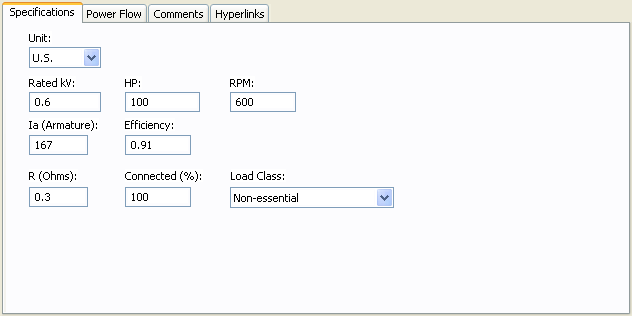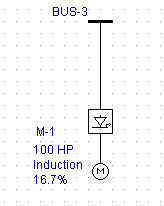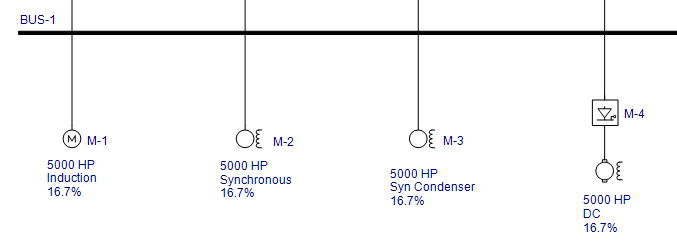Motor - Specifications Tab
See also: DC Motor Specifications Tab

Figure 1: Specifications Tab

Figure 2: Specifications Tab (Metric)
| Option | Description |
|---|---|
| Unit |
Choose either US or Metric. |
|
Power Type |
The power type for the motor. Select from:
|
|
kV |
Motor rated kV. This is normally 460 volts on a 480 volt base, or 2300 volts on a 2400 volt base. |
|
Motor horsepower. Motors may be represented individually or as a lumped group. For a grouped motor, enter the total horsepower for the group. This displays if the unit selected is US. |
|
|
kW |
Motor kilowatts. Motors may be represented individually or as a lumped group. For a grouped motor, enter the total kilowatts for the group. This is displayed if the unit selected is metric. |
|
RPM |
Revolutions per minute. Used in output reports and defining equipment for ANSI or IEC standard short circuit calculation multipliers. By default, ANSI uses 1800 and IEC uses 1500, unless the default equipment settings for motors are set to use a different value. |
|
Load Class |
To specify the class in terms of importance. You can select Essential, Critical, or Non-essential. This field does not affect analysis. It can be used in database query to distinguish a certain load class from others. See Advanced Query for more information. |
|
FLA |
Calculate looks up full load amps from NEC tables if the motor HP is listed in an NEC table. The full load amps field is not required, but a value greater than 0 affects how kVA is calculated. See Motor kVA Calculations. |
|
Motor operating power factor. This is used with the Efficiency field to determine kVA. Motor groups should use an average value of power factor. |
|
|
Eff |
Motor operating efficiency. This is used with the Power Factor field to determine kVA. Motor groups should use an average value of efficiency. |
|
Service Factor |
The factor by which the motor can be safely overloaded. You can select any value between 1.0 and 1.25. |
|
Demand Factor |
This factor is used to calculate the Demand kVA or Amps for the motor. The demand factor for a motor would be the ratio of maximum motor load to total rating of the motor. |
| One-line Graphics | |
|
With Adjustable Frequency Drive |
Selecting this check box changes the motor symbol in the one-line as shown below.
|
|
Motor type (induction, synchronous, synchronous condenser, or DC). This choice affects the motor impedances for short circuit calculations. The type also determines the one-line symbol for the motor. These are the symbols if that are produced for each of the motor types if the connection type is D (delta) or Y (wye), which are both ungrounded types:
These are the symbols that are produced for each of the motor types if the connection is YG (grounded wye):
|
|
DC Motor Specifications Tab

Figure 3: Specifications Tab for DC Motors
| Option | Description |
|---|---|
|
Unit |
Choose either US or Metric. |
|
Rated kV |
Motor rated kV. |
|
Motor rated horsepower (U.S. units) or kilowatts (metric units). |
|
|
RPM |
Revolutions per minute. |
|
Ia (Armature) |
Rated armature current in amps. |
|
Efficiency |
Ratio of output mechanical power to input power. |
|
R (Ohms) |
Armature resistance in ohms. This affects the short circuit contribution. |
|
Connected (%) |
Scales the short circuit contribution from the motor. |
|
Load Class |
To specify the class in terms of importance. You can select Essential, Critical, or Non-essential. This field does not affect analysis. It can be used in database query to distinguish a certain load class from others. See Advanced Query for more information. |
More Information
- Motor Data
- Motor kVA Calculations
- Database Dialog Box Toolbar
- Motor - Connection Information
- Motor - Specifications Tab
- Motor - Short Circuit Tab
- Motor - TCC Tab
- Motor - Power Flow Tab
- Motor - Motor Starting Tab
- Motor - Harmonics Tab
- Motor - Stability Tab
- Motor - Reliability Tab
- Motor - Location Tab
- Motor - Comments Tab
- Motor - Hyperlinks Tab
- Motor - Collected Data Tab
- Motor - Media Gallery Tab




